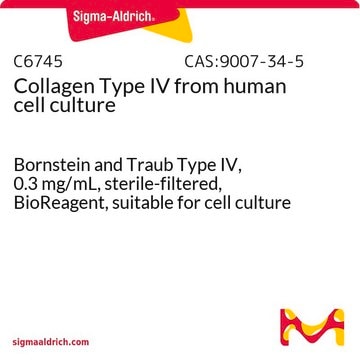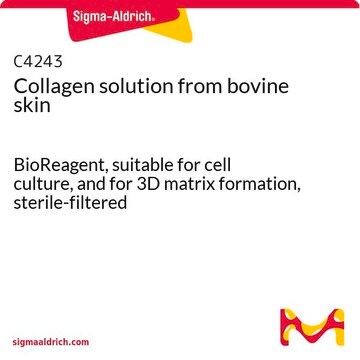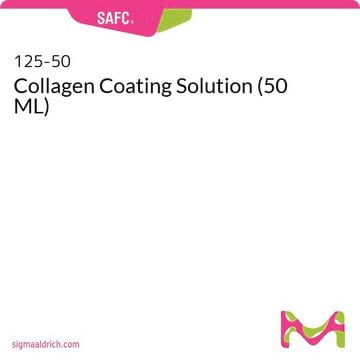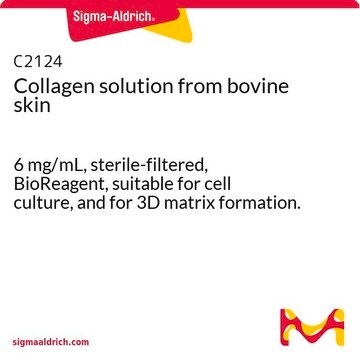As indicated above under 'PROPERTIES', this collagen solution is sterile-filtered.
推荐产品
产品名称
胶原蛋白溶液 来源于人类成纤维细胞, 3 mg/mL, sterile-filtered, BioReagent, suitable for cell culture
生物来源
human fibroblasts
质量水平
无菌性
sterile-filtered
产品线
BioReagent
表单
solution
包装
pkg of 20 mL
浓度
3 mg/mL
技术
cell culture | mammalian: suitable
表面覆盖度
6‑10 μg/cm2
结合特异性
Peptide Source: Collagen
Peptide Source: Elastin
异质活性
endotoxin ≤5.0 μmole/min-mg protein
运输
wet ice
储存温度
2-8°C
相关类别
一般描述
储存分类代码
10 - Combustible liquids
WGK
nwg
闪点(°F)
Not applicable
闪点(°C)
Not applicable
其他客户在看
商品
Extracellular matrix proteins such as laminin, collagen, and fibronectin can be used as cell attachment substrates in cell culture.
细胞外基质蛋白质,如层粘连蛋白、胶原蛋白和纤连蛋白,可用作细胞培养中的细胞附着基底。
-
How did you steralize this collagen?
1 answer-
Helpful?
-
-
Is this product suitable for 3D gel formation? How should it be neutralized? How quickly does it polymerize once neutralized? Is there a protocol available for 3D gel formation?
1 answer-
Procedure for 3-D Gel Preparation:
1. Mix 8 parts of chilled collagen solution with 1 part of
10 X PBS (Catalog Number P5493 or P5368) or
10 X culture medium. Cells may be added following
this step.2. Adjust pH of mixture prepared in step 1 to 7.2–7.6.
Use of 0.1 M NaOH (10-fold dilution of Catalog
Number S2770) or 0.01 M HCl (100-fold dilution of
Catalog Number H9892) is recommended. Monitor
pH adjustment carefully with pH meter, phenol red,
or pH paper.3. To prevent gelation, maintain temperature of the
mixture at 2–8C. To form gel, warm to 37C. For
best results allow 45 minutes to 1 hour for gel
formation.4. The gels can be dried under a laminar flow hood.
Helpful?
-
-
Is the monomer a tropocollagen?
1 answer-
The human collagen is secreted from fibroblast cells, which cleave the loose ends of the procollagen molecule, leaving what is considered tropocollagen with the telopeptide region intact. An enzyme step is utilized to cleave the telopeptide, resulting in Atelocollagen, which maintains its triple helical formation but without the telopeptide region.
Helpful?
-
-
What is the 2D Hydrogel protocol for Product No. C2249?
1 answer-
There has been no internal protocol for C2249 however this paper describes protocol for 2D Collagen Gel. Hong H, Stegemann JP. 2D and 3D collagen and fibrin biopolymers promote specific ECM and integrin gene expression by vascular smooth muscle cells. J Biomater Sci Polym Ed. 2008;19(10):1279-93. doi: 10.1163/156856208786052380. PMID: 18854122; PMCID: PMC2731795.
Helpful?
-
-
Is this a monomer?
1 answer-
This product is a mix of monomers, dimers, trimers, and oligomers, with some remaining collagen fragments.
Helpful?
-
-
What solvent is used for product C2249?
1 answer-
The solvent for product C2249 is 13 mM HCl.
Helpful?
-
-
What is the acid, and concentration of acid, that the collagen is solubilized within?
1 answer-
The acid used to prepare this product is HCl. The final concentration of the solvent is 13 mM.
Helpful?
-
Active Filters
我们的科学家团队拥有各种研究领域经验,包括生命科学、材料科学、化学合成、色谱、分析及许多其他领域.
联系客户支持








